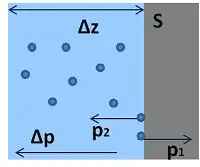The radiation pressure varies with the phase velocity of the light, not the group velocity, although you must keep in mind that the phase velocity in matter might be different from $c$ and vary with wavelength in a dispersive medium.
This has been experimentally demonstrated and described in this paper, in which it was found that the radiation force felt on a mirror will vary in direct proportion to the index of refraction of the material in which the mirror is immersed.
Intuitively, for higher index of refraction (slower phase velocity), there are more photons per unit length, increasing their energy density and pressure.
While the pressure on the mirror once the photons arrive will depend on the phase velocity, the group velocity still controls the rate at which information can be transferred.
Update
To be explicit, for a beam of photons with wavelength $\lambda_0$ emitted with power $P$ traveling through a medium with index of refraction $n(\lambda_0)$ impinging directly on a mirror immersed in that medium (angle of incidence is zero), the force $F$ felt by the mirror is given by
$$ F = \frac{2 n(\lambda_0) P}{c} \, \, .$$
The index of refraction is related to the phase velocity at that given wavelength, $v_{ph}(\lambda_0)$, by the relation
$$ n(\lambda_0) = \frac{c}{v_{ph}(\lambda_0)} \, \, ,$$
so that the radiation force for this single-wavelength beam can also be written as
$$ F = \frac{2 P}{v_{ph}(\lambda_0)} \, \, .$$
For light composed of a range of wavelengths, you must integrate this expression over the photon distribution of the beam with respect to wavelength, taking into account how the index of refraction varies with wavelength.
Further update (microscopic description)
Microscopically, you can think of the momentum being carried simultaneously by the E&M fields, and "an additional co-traveling momentum within the medium from the mechanical momentum of the electrons in the molecular dipoles in response to the incident traveling wave" (J.D. Jackson, Classical Electrodynamics 3rd edition, p. 262, and its corresponding reference to this paper).
